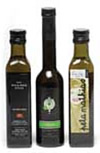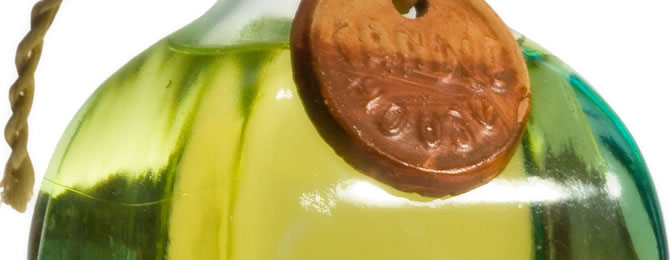Olive oil in NZ reviewed by Consumer magazine (Synopsis of their article)
You can pay top dollar for extra-virgin olive oil. But the best indicator of a good oil is freshness – the top oils in Consumer’s tasting were pressed this year.
Extra-virgin olive oil is produced without heat or chemicals. The International Olive Council (IOC) says that extra-virgin oil must meet certain analytical criteria and be free of defects when the oil is tasted by a sensory panel trained to IOC standards.
We were looking for well-balanced oils that had good aroma and flavour – and no defects. Colour has nothing to do with the quality of olive oil. Oils are tasted in blue glasses so the colour is masked.
We were disappointed in the overall results. Too many oils (mainly imported) fell into the “unacceptable” category when tasted. Retailers and importers need to do a better job of packaging and displaying extra-virgin olive oil.
Packing it in clear bottles and exposing it to artificial light for long periods will only result in the oil deteriorating.
Extra-virgin olive oil is an expensive semi-luxury product. It should be looked-after better so that consumers receive the quality product they’re paying for.
Kiwi oils come out top
All the oils passed the chemical analysis we put them through, but there was a wide range in their sensory quality.
Fresh is best! The three top oils in our tasting were pressed in May or June 2008.
 The Peta Mathias, Olivo and The Village Press Frantoio oils all had the qualities our judges were looking for – good aromas with lots of olive fruity flavours. They were also well balanced.
The Peta Mathias, Olivo and The Village Press Frantoio oils all had the qualities our judges were looking for – good aromas with lots of olive fruity flavours. They were also well balanced.
These three oils were also in dark bottles, which are better protected from the light. Clear bottles are a problem, especially in supermarkets where the oils sit under fluorescent lights. Some supermarkets are open for 24 hours and this increases the light-exposure.
The Borges, Pams and Paul Holmes Leccino oils were also very good. But the Borges and Pams had no date marking. We may have struck a fresh batch of these but there’s no way of knowing – and other Borges and Pams on shop shelves may be older.
Tired oils
The most common complaint about the unacceptable oils was that they were tired. Tired oils taste “old” and not fresh – it’s a sign an oil is starting to go rancid. But many oils don’t give you enough information on the labels to judge.
Most oils state a best-before date, although that’s no guarantee of quality. Many of the unacceptable oils were well within their best-before date. Colonna, La Espanola and Mas Portell Arbequina were judged unacceptable even though they had best-before dates in 2010 – that’s over a year away.
The problem with best-before dates is you don’t know how old the oil is. Six oils stated their pressed-on date. This is more helpful because you know exactly how old the oil is. We’d like to see pressed-on dates for all extra-virgin olive oil.
Some oils didn’t do as well as they did in our 2006 tasting. Kapiti was one of our top oils in 2006 but this time our panel rated it poorly. The producers are concerned that their oil isn’t being stored properly in shops and is following up this issue with retailers.
Ravida also got a lower rating. The importer told Consumer the size of Ravida shipments has been reduced to ensure a fresher product in New Zealand.
Article from Consumer Magazine, December 2008 by Belinda Allen
Consumer recommends
These three Kiwi olive oils were the best in our tasting. They also came in dark bottles and had pressed-on as well as best-before dates.
The Village Press Frantoio
Olivo
Peta Mathias
Buying advice
Buy the freshest oil possible. Look for a “pressed-on” date, as best-before dates aren’t a good indicator of quality. We’d like to see “pressed-on” dates for all extra-virgin olive oil.
Heat and light will affect oil quality. Don’t buy clear-bottled oils, especially ones that have been displayed in a shop window or under fluorescent light.
Store in a cool dark place, tightly stoppered. Once bottles are open they are best stored in the fridge. The oil may become cloudy or solid. This won’t affect the taste and it will clear when brought to room temperature.
Oils don’t improve with age – use them as quickly as you can.
Country of origin
Buying extra-virgin olive oil from Italy? You need to check the labels carefully – chances are it’s not made from Italian olives at all.
Spain is the biggest producer of olives and olive oil. Italy is the second-biggest producer. But, because the Italians are the biggest consumers of olive oil, Italy doesn’t produce enough olives to meet local demand. A lot of the Spanish crop is exported to Italy, where it’s repackaged for sale as Italian olive oil. Other countries such as Greece and Turkey also export olives to Italy.
Lupi says it’s “imported from Italy”. This gives the impression that the olives were grown in Italy but it probably only means the oil was bottled there. Rizzoli is a bit more upfront – the label says it’s “bottled in Italy”.
If you’re looking for olive oil made with Italian olives look for the label “Product of Italy” or “Produced and bottled in Italy”.
Whey protein promises nano-encapsulation of omega-3
The whey protein beta-lactoglobulin may spontaneously bind the omega-3 fatty acid docosahexaenoic acid (DHA) and offer nano-encapsulation potential for formulators.
Israeli researchers report that the whey protein may be a nano-vehicle for DHA, and nano-complexes with pectin produced transparent dispersion with extended shelf-life for the ingredient. They report their results in an upcoming issue of Food Hydrocolloids.
“The new technology presented herein may serve to enhance the health promoting properties of beverages and foods while maintaining transparency and providing substantial protection to the encapsulant against deterioration during product shelf life,” wrote Patricia Zimet and Yoav Livney from the Israel Institute of Technology in Haifa.
Zimet and Livney also note that this is the first time that the spontaneous binding of an omega-3 fatty acid to beta-lactoglobulin has been reported.
Study details
Omega-3 fatty acids are one of the success stories in health and wellness circles. However, their use in foods is limited by their low solubility in water and their sensitivity to spoilage by oxygen. Encapsulation is one method or protecting the oils.
For the new study, the Haifa-based researchers investigated the potential of beta-lactoglobulin to spontaneously bind to DHA and to act as a carrier for the fatty acid.
In combination with low-methoxy pectin, colloidally stable nanocomplexes of DHA-and beta-lactoglobulin were produced. An excess of pectin led to the formation of particles containing 166 times more DHA than the surrounding solution, added Zimet and Livney.
Moreover, the particles were transparent and their average size was about 100 nanometres.
Further experiments studied the stability and shelf-life of the resulting nano-complexes. An accelerated stress test (100 hours at 40 degrees Celsius) showed that only between 5 to 10 per cent of the DHA was degraded when bound with the whey protein. On the other hand, about 80 per cent DHA degradation is observed for
Source: Food Hydrocolloids
Volume 23, Issue 4, Pages 1120-1126
“Beta-lactoglobulin and its nanocomplexes with pectin as vehicles for ω-3 polyunsaturated fatty acids”
Authors: P. Zimet, Y.D. Livney
Book Review
Life – As a Matter of Fat – The Emerging Science of Lipidomics
edited by Ole G. Mouritsen (Springer Frontiers
Collection), Springer, Berlin (Germany) 2005. Hardcover,
290 pages. Price 53.45 e. ISBN-13 978-
3540232483.
Presenting challenges and open problems at the forefront of modern physics in a manner accessible to scientifically literate non-specialists is the expressed aim of the Frontiers Collection by Springer. This is exactly what Mouritsen achieves with his book, the reader gains insight into the deeper implications and the fascinating questions involved.
The field of lipid research is central to essential aspects of life, e.g. its origin, its metabolic regulation, the brain, and decays in various forms. Traditional approaches to lipid research through physics, chemistry, biology, and medicine are complemented by nanotechnology, high throughput technologies, etc., and are now rapidly evolving into a multidisciplinary science, the lipidomics enterprise.
For lipids it is the third in a row of “omics”, after genomics and proteomics, that strives to put the “heap of stones into the shape of a house” (Pointcare).
As Mouritsen puts it: a new lipidomics science has to go beyond the mapping of all lipid species in all cell types and must approach cellular functioning from a more holistic perspective. The present state of affairs is still largely such that the answers are there, but what were are the questions? This book is a plea for hypothesis-driven science that has to follow the undoubtedly necessary efforts of stamp collection.
In that sense, the book is wonderfully exciting to read. It is structured into three parts: the first part (The Overlooked Molecules) describes in seven chapters the molecules, their chemistry and physics, and introduces the concept of larger shape creation through self-assembly. It ends by a six-page essay on “Models and Fashion”. As with all complex systems, models are important as nuclei for structured debate. With biological membranes, where the enormous breadth of scales in sizes (from Angstroms to millimeters) and in times (from picoseconds to days) exceeds normal imagination, this structuring power of models is of particular importance.
Mouritsen gives a lucid critique on the existing membrane models.
Remarkably, this chapter does not contain the fashionable “rafts”, which are found in almost every selfesteeming publication on membrane biophysics of today, but have not yet been seen in reality. No fear, however, rafts do appear in the following part.
The second part (Lipids Make Sense) is devoted to the structural and dynamic organization of lipids at the supramolecular level. It covers the “phase” aspect with all its associated phenomena, such as transitions, separations, fluctuations, also “rafts”, and interactions, arriving finally at the interaction with proteins. This part indeed covers a selection of relevant concepts and essential phenomena without getting into the maze of too many experimental results.
The third part focusses on function (Lipids in Action). Cholesterol makes the start, as it does in the history of lipid science. This is followed by a brief chapter on how lipids match up with proteins – the mattress model and hydrophobic mismatch concept, among others. Then the text shifts to nutritional aspects of essential fatty acids, and how a physicist can rationalize such diverse phenomena of life, as e.g. anesthesia, obesity, and apoptosis.
‘Smart nanotechnology’ stands at the end of this selection of examples.
A whole legion of scientific texts on membranes and lipids have appeared over the past five decades, starting with the classics of Dennis Chapman in the late Sixties, some more and some less memorable. This book of Mouritsen is different in being very readable, stimulating and concise.
Perhaps not unintentionally, its rather decent, unseeming layout – no glossy charts and pictures, no flashy highlights or boxes – supports its impression on the reader who wants to be seriously informed of current ideas and concepts, rather than be carried away with facts and figures. It will be an excellent companion for lipidologists, membranologists and lipidomiacs at all levels of expertise for time to come. It can be particularly recommended as a text for interdisciplinary university courses in life sciences.


